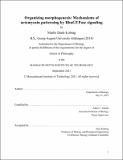Organizing morphogenesis: Mechanisms of actomyosin patterning by RhoGTPase signaling
Author(s)
Denk-Lobnig, Marlis
DownloadThesis PDF (9.150Mb)
Advisor
Martin, Adam C.
Terms of use
Metadata
Show full item recordAbstract
Morphogenesis is an astonishing orchestration of molecules, cells and tissues, of signaling and mechanics, across space and time. How are its components choreographed across scales? This thesis investigates this question in the context of Drosophila ventral furrow formation, a well-established, simple model of tissue folding. First, we demonstrated how, on the tissue level, combinatorial activation of two transcriptional tissue patterns sets up actomyosin distribution. This tissue-level actomyosin pattern is tuned by the balance of two RhoA GTPase regulators, RhoGEF2 and C-GAP and in turn regulates the curvature of the resulting fold. We then investigated how myosin organization on the cell-level is concerted by RhoGEF2 and C-GAP interplay. We found that the balance of RhoGEF2 and C-GAP regulates the size of an active myosin patch at the constricting apical cell surface, but that both regulators act partially synergistically in promoting temporal myosin dynamics. Overexpression of both regulators together causes a distinct myosin spatiotemporal pattern, suggesting that RhoGEF2 and C-GAP are more than simple antagonists and their regulatory interactions provide essential components of myosin patterning and organization. In summary, this thesis provides insight into how a simple and common regulatory module organizes contractility in the ventral furrow across multiple scales, in space and time.
Date issued
2021-09Department
Massachusetts Institute of Technology. Department of BiologyPublisher
Massachusetts Institute of Technology